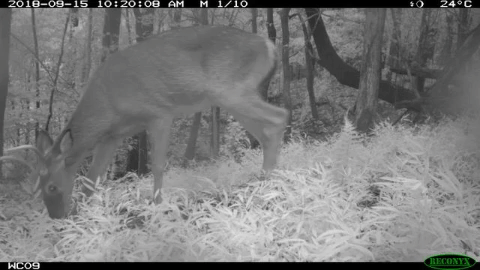*This post contains affiliate links. As an Amazon Associate, I earn from qualifying purchases. Read my Affiliate Links Disclaimer.
Hurricane Florence is coming and I have camera traps out for an experiment that I am not taking down. I’ll be able to see how mammal activity changes before and after the storm and might even capture some reactions to storm damage. This got me thinking about how mammals fare during hurricanes, at least the ones we typically get on camera trap. We photograph mostly white-tailed deer, raccoons, Eastern grey squirrels, opossums, coyotes, red and grey foxes, and Eastern cottontails. I did a literature search to see what the science says.
Results on camera trap mammals in the Southeast USA:
- 32 radio-tracked deer all survived Hurricane Andrew in 1992 in the Everglades, but conception rates, fetus, and fawn survival decreased afterward. Surprisingly, the deer didn’t change their movement patterns any differently than from pre-hurricane years.

- After Hurricane Hugo,there was no observable widespread wildlife mortality in a South Carolina wildlife refuge. Squirrels suffered from loss of fall litters and damage to trees, affecting their food supplies. However, there was mortality on an island that experienced high storm surge.

- On islands in Lousiana post Hurricane Katrina, raccoons and eastern cottontail were the most resilient species, while deer and fox squirrels (similar to grey squirrels) did not survive on some islands.
- After Hurricane Betsy in 1965, scientists reported a dead raccoon every ten yards or so along on an island where a research laboratory was in Mississippi. After Hurricane Camille in 1969, there were more animal mortalities in the same location, and the squirrels virtually disappeared for a few weeks. It took a year for them to get back to their former numbers.

- After Hurricane Audrey, there was an estimated a 60% loss of raccoon, rabbit, and deer at Rockefeller Refuge in Louisiana (Reported in Cely 1989).
- A hurricane in 1950 caused little mortality to deer and there were lots post hurricane in Gulf Hammock, Florida (Reported in Cely 1989).
Impacts on Other Animals
It’s important to note that this post only covers mammals that we can camera trap in North Carolina. There are more studies on the impacts of rodents, which are usually too small and/or too much in the leaf litter to show up on camera traps. There’s also more studies on the impacts to birds and marine species, as hurricanes seem to be much harsher for them. They can blow birds off course, destroy nesting habitats, and cause mortalities. Finally, species that already are threatened are endangered will likely suffer the most. For example, ~14-22 percent of the endangered Key deer population was killed by Hurricane Irma in 2017.
What Happened on My Camera Traps?
I predicted most animals would just hide and wait out the storm. Well, I was right! Turns out, I got a whole lot of NOTHING. These camera traps are so good (Recoynx are my favorite), that I didn’t even capture empty photos of blowing vegetation. Almost all had no triggers for the ~3 days of rain and wind. This camera trap, however, captured a sequence of two deer braving it out on a windy and rainy day. It is also worth mentioning that in Raleigh, the hurricane was not as impactful as was predicted, given the storm took a turn southward. But we still got lots of rain and wind.

All camera trap photos are from the eMammal project that I work on.
Love this post? Share it with friends!



